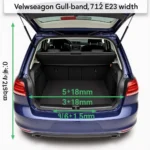Electric vehicles are increasingly hitting the roads, but charging infrastructure often lags behind. Long charging times present a hurdle for many drivers. Nio is taking a new approach here with an innovative concept: Nio Swapping Stations. In this article, you will learn exactly what this entails, what advantages this technology offers, and whether it is the future of charging.
 Exterior view of a Nio battery swapping station
Exterior view of a Nio battery swapping station
What Are Nio Swapping Stations?
Nio Swapping Stations allow owners of a compatible Nio electric vehicle to exchange their depleted battery for a fully charged one within minutes. The process is similar to refueling at a conventional gas station: Instead of charging, the battery is simply swapped.
This concept represents an interesting alternative to conventional charging, especially for long distances or when time is limited. “Battery swapping is a promising solution for drivers covering long distances or who don’t have time to charge,” says Dr. Markus Müller, automotive expert at the Technical University of Munich. “Nio is a pioneer here and could revolutionize the mass market for electric vehicles with this concept.”
How Does Battery Swapping Work at a Nio Swapping Station?
Battery swapping at a Nio Swapping Station is fully automated and takes just a few minutes. The driver pulls into the station and parks their vehicle in the designated spot. A robotic arm then removes the depleted battery from the underside of the vehicle and replaces it with a fully charged one. The driver does not need to exit the vehicle during the entire process and can conveniently monitor the battery status via the in-car display.
 Automated robotic arm replacing an EV battery pack
Automated robotic arm replacing an EV battery pack
Advantages of Nio Swapping Stations
Nio Swapping Stations offer several advantages over conventional charging: Speed: The battery swap takes only a few minutes, making it significantly faster than charging at a fast-charging station. Flexibility: Drivers are not tied to long charging times and can quickly resume their journey. Convenience: The battery swap is fully automated, and the driver does not need to exit the vehicle during the process. Future-proofing: Through battery swapping, drivers can benefit from future battery technologies with higher energy density.
Challenges and Future Perspectives
While Nio Swapping Stations offer many advantages, there are also challenges: Infrastructure: Building a widespread network of swapping stations is cost-intensive. Compatibility: Currently, only Nio vehicles are compatible with the swapping stations.
Nevertheless, battery swapping is considered a promising technology for the future of electric mobility.
Conclusion
Nio Swapping Stations offer an interesting alternative to conventional charging and could further increase the acceptance of electric cars. Whether this technology will prevail in the long term depends on various factors, such as the expansion of the charging infrastructure and acceptance by other automotive manufacturers. Would you like to learn more about Nio’s innovative technologies? Visit our website autorepairaid.com for more information and expert tips on electric mobility.

